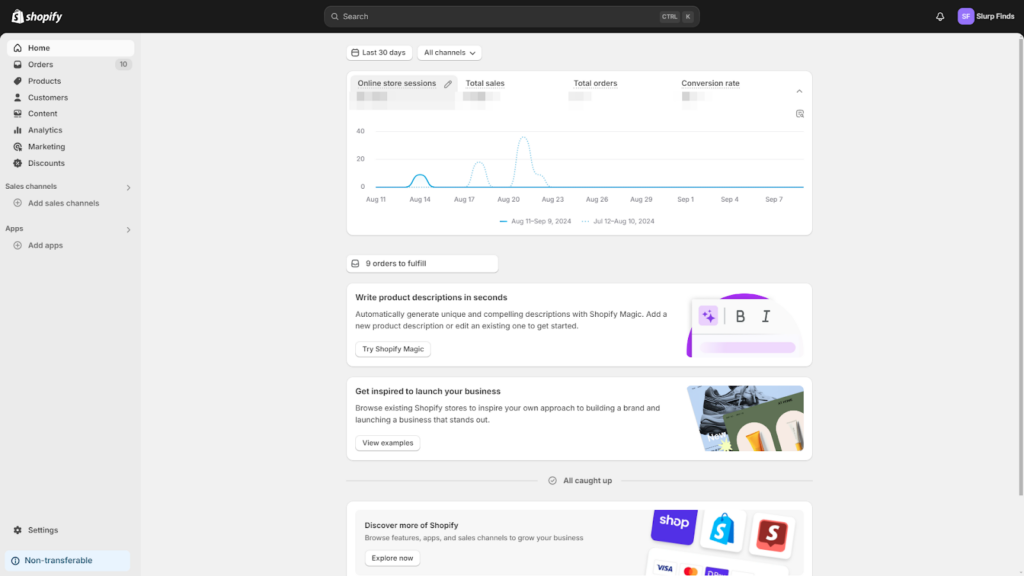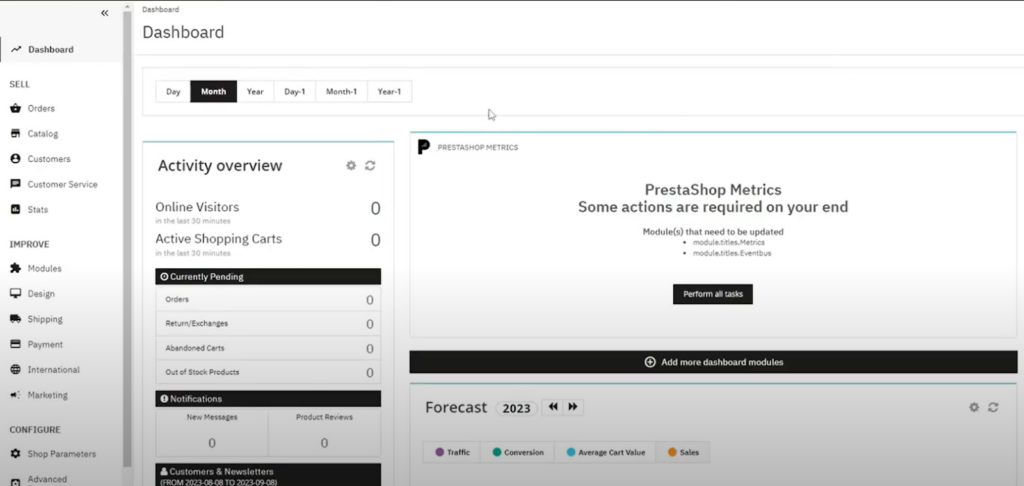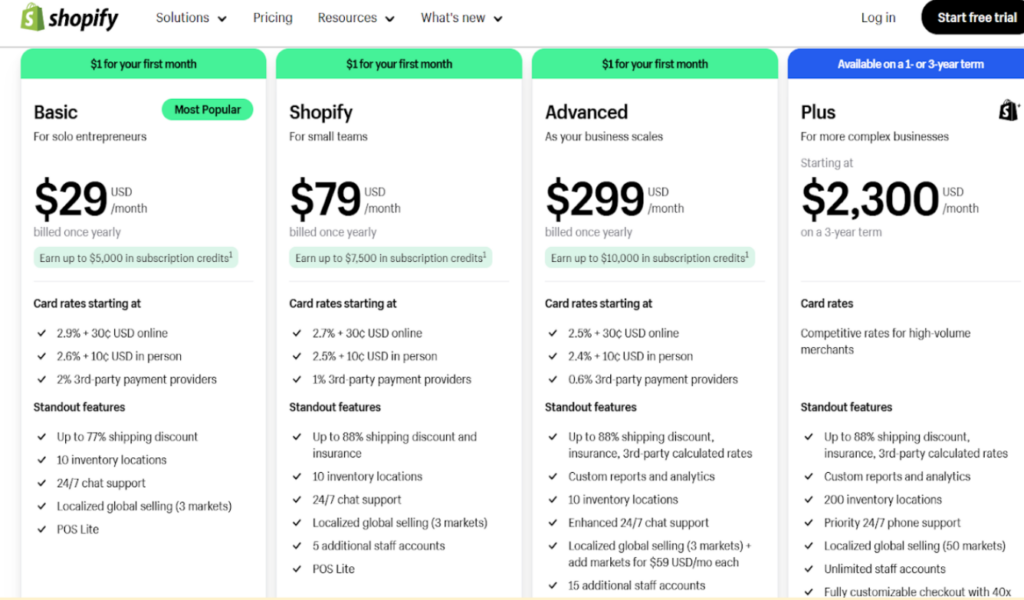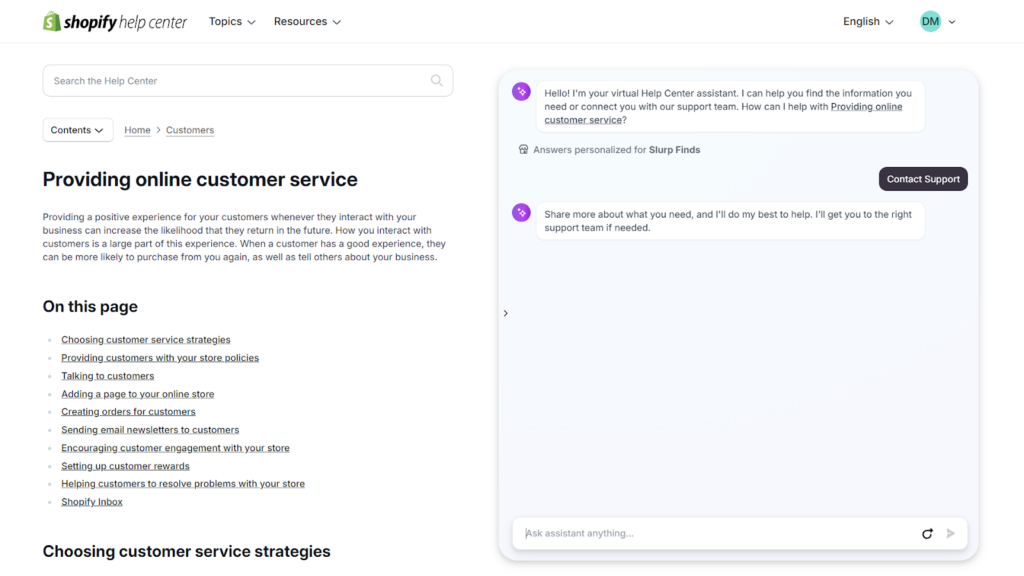Shopify Vs PrestaShop — Which One is Better?

Choosing the right platform is highly necessary for your online business.
When you choose a perfect platform for your business, you can effortlessly reduce operational expenses and manage your online business without any complexity.
Shopify and PrestaShop are two great options for that matter.
Shopify is known for its simplicity and user-friendly interface, while PrestaShop offers greater control and customization for users with technical skills.
Both platforms are SEO-friendly and beginner-friendly, but they differ significantly.
In this article, we’ll break down how both of these platforms differ, helping you choose the right one for your business needs.
Let’s start with out in-depth comparison guide, starting with the introduction.
Shopify Vs. PrestaShop — Understanding the Platforms
Below, I’ve provided a basic overview of each platform to help you understand their key differences.
Shopify

Shopify is an eCommerce platform that has all the features for starting, managing, and growing your online business. Its intuitive interface and budget-friendly nature make it an excellent choice for streamlining your operations and managing your online store efficiently.
Shopify is a subscription-based online store builder, which comes in three different pricing plans:
- Basic Shopify (for individuals & small businesses)
- Shopify (for small businesses)
- Advanced Shopify (for medium to large businesses)
Additionally, all pricing tiers include comprehensive tools designed to effectively manage your business operations on the platform. You also get a 3-day free trial to explore Shopify’s features.
Shopify comes with a variety of built-in features, including customizable themes, a wide selection of apps, 200+ well-designed templates with an easy-to-navigate interface, and unique tools like Shop Pay for faster checkouts. It also offers its own payment system, a point-of-sale system, tax calculation tools, and a CRM to manage customer relationships, making it a comprehensive solution for online store management.
Moreover, Shopify provides access to other sales channels without paying any extra money. By linking each channel to your store, you may sell on prominent online marketplaces like Facebook, Instagram, Messenger, and more with Shopify.
PrestaShop

PrestaShop is an open-source platform that allows building an online store without any fixed fees or subscription charges coming with it. However, you have to pay for domain name, web hosting, and other additional features.
With PrestaShop, you get full access to the source code of your online store, which allows you to take control of sales, data, management, design, and other functionalities of your online store.
In addition, it provides a wide array of apps and add-ons, offering plenty of exciting features for online shops. You’ll find various payment options, streamlined checkout processes, and efficient order and shipping management, all designed to enhance the shopping experience.
Moreover, PrestaShop is highly customizable, giving you full access to the code, and allowing you to tailor your store to your exact needs. Plus, with the help of third-party modules, you can discover powerful features that further enhance your shop’s functionality.
This flexibility makes PrestaShop a versatile choice for those who want to build a unique online shopping experience.
;
This was a basic overview of these platforms. The next section will provide a clearer comparison of Shopify vs PrestaShop, breaking them down across various key criteria.
Shopify Vs PrestaShop — How They Stack Up Against Each Other?
Both Shopify and PrestaShop have multiple advanced features. By comparing the platforms, you can make a well-informed choice, ensuring the best fit for your online store’s growth and management. This section will provide a detailed comparison between Shopify and PrestaShop for your better understanding.
Let’s begin with a detailed comparison table for a clear overview:
| Aspect | Shopify | PrestaShop |
| eCommerce Features | Availability of 4,000+ modules | Availability of 4,000+ modules |
| Cost | Have a subscription plan starting from $22 to $299/month | Free to download & install with no monthly fees |
| Designing | Offer 260 templates | Offer 2,500+ templates |
| Extendability | No access to the core file | Access to the core file |
| User Interface | User-Friendly | SEO-Friendly |
| SEO | Weak in-built SEO requires further paid module installations | SEO-Friendly |
| Commissions | Commission range: 0.5% to 2% | No Commissions |
| Languages Supported | Supports 21 languages | Supports +75 languages |
| Multi-Store Management | No, requires further paid module installations | ✅ |
| Themes & Extension Marketplace | ✅ | ✅ |
This comparison table provides a clear overview of key features, helping you weigh the strengths and weaknesses of each platform to make an informed decision tailored to your business needs.
Now, join for a detailed analysis of Shopify and PrestaShop covering themes, scalability, and more.
1. Ease Of Use
Every store owner needs an eCommerce platform that is easier to set up and manage day-to-day operations. Let’s check if Shopify or PrestaShop has an easier dashboard to work with.
Shopify is renowned for its user-friendly interface, providing a straightforward dashboard with features like orders, analytics, and marketing, making it easy for beginners to create an eCommerce store. After selecting a plan and creating an account, you simply choose a store name. Shopify’s homepage then walks you through the setup process with clear instructions and quick-access links to ensure a smooth start.

In addition, it allows you to customize your website with minimum technical knowledge. You can also find tips for improving a store, like establishing a shipping policy and learning more about selling abroad. You can also access helpful tips for improving your store, such as setting up a shipping policy and expanding your business by learning about international selling strategies.
PrestaShop, on the other hand, also provides an intuitive dashboard where it has built-in features like orders, catalog, customer service, and more.

Setting up an online business with PrestaShop is relatively straightforward. However, if you want to create a store with advanced functionalities, a deeper knowledge of coding is essential for optimizing and customizing the platform.
Moreover, the PrestaShop dashboard features sections like Activity Overview and Products and Sales, where you can track the growth of your store. Also, it has a Quick Access button for accessing common tools.
So yes, Shopify is the more user-friendly eCommerce platform overall, but PrestaShop can be just as easy to set up with the right user-friendly web hosting.
2. Pricing
Pricing is a crucial factor because it directly impacts your budget and the long-term sustainability of your online store, influencing your ability to scale and invest in other business areas.
Shopify and PrestaShop both have different pricing plans, depending on your specific needs. Let’s check pricing plans for both of these platforms first.
Shopify Pricing
Shopify is a hosted eCommerce platform, which offers 3 plans to choose from. Basic Shopify, Shopify, and Shopify Advanced. It has per month ranges from $29 to $299 (if paid annually).

Let’s explore Shopify pricing by considering these points:
- For complex businesses, where advanced features and handling high-traffic websites are paramount, it has Shopify Plus, starting at $2,300/month for a 3-year term.
- Moreover, Shopify has additional pricing alternatives for your business – Starter ($5/month) and Retail ($60/month). Note that Shopify doesn’t offer any free plan. However, you can get its 3-day free trial to learn about its various features.
- To enhance the website’s functionalities, you may opt for themes and apps that will increase your Shopify pricing by around $200 – $1000.
PrestaShop Pricing
With PrestaShop, you can download and install it for free, due to its open-source nature. However, you need to invest in web hosting, domain name, and other additional features.
Also, to make your store visually appealing, you need a well-designed PrestaShop template – which costs from $91 to $303. Then, to improve your store’s functionality, you’ll need to integrate with PrestaShop add-ons. These extensions may increase your PrestaShop cost by $35 to $6000.
After taking multiple factors into account, it’s fair to say that Shopify has more straightforward pricing plans to start your business with ease. Whereas PrestaShop has a complex pricing plan and can be more expensive than Shopify.
3. Themes
Themes set the tone for any eCommerce website.
The more engaging, responsive, and user-friendly the theme, the longer your customers will stay, improving their overall experience and increasing conversion rates.
Shopify Themes

Once you sign up for Shopify, you have access to over 180 themes, both free and premium, ranging from $0 to $400. These themes are designed by professionals, ensuring your store has a polished look.
Additionally, Shopify provides customization options with CSS and Shopify Liquid, which allows you to personalize your site’s design and features to match your desires.
PrestaShop Themes

PrestaShop offers a more extensive selection of themes, with over 1,600 available. Being open-source, it gives you complete control over your website’s design. With knowledge of HTML, CSS, or JavaScript, you can fully adjust the underlying code to build a highly customized store that perfectly fits your business needs.
Shopify stands out with its easy-to-use interface, making it ideal for those seeking a straightforward setup. On the other hand, PrestaShop gives you the freedom to create a fully customized experience, especially if you have advanced technical skills.
In conclusion, while Shopify offers ease of use with its professionally designed themes, PrestaShop allows for deeper customization, giving you more control over every detail of your store.
4. Apps & Extensions
Apps and extensions are highly necessary when you want additional features other than those created by eCommerce platforms. Let’s check how Shopify and PrestaShop help with it.
Shopify has a well-established app store with over 8,000 apps, offering solutions for everything from marketing and customer support to shipping and inventory management. These apps are tested by Shopify to ensure compatibility, making it easy to customize your store without worrying about performance issues.

Shopify also provides features like side-by-side app comparisons and filters, allowing you to refine search results and find the right app quickly.
The “Staff Picks” section highlights recommended apps, streamlining the decision-making process. Whether you’re a small business or an enterprise-level company, Shopify’s extensive app ecosystem makes it highly adaptable.
PrestaShop, on the other hand, offers over 4,000 modules through its PrestaShop Addons Marketplace. These modules allow store owners to enhance site functionality by improving conversion rates, managing multiple stores, and optimizing customer experiences.

PrestaShop’s modules are focused on providing more flexibility for advanced users who want greater control over customization, particularly in managing multiple stores and adding specific, custom features.
However, the selection is smaller compared to Shopify, and integrating modules can be more hands-on, depending on the hosting and server setup.
Shopify’s larger number of apps, combined with its easy-to-navigate store and filtering options, makes it a more convenient choice for users looking for variety and simplicity. PrestaShop offers solid customization through its modules but may require more technical involvement, which is ideal for businesses seeking specific, tailored solutions.
5. Performance & Scaling
When choosing an eCommerce platform, you must choose the one with better performance and scope for business expansion. Let’s compare Shopify and Prestashop for the same.
Shopify includes hosting services with its subscription plans, ensuring consistent performance and uptime.
With a loading speed under 1.3 seconds, Shopify provides a high-performing eCommerce solution. For even better performance, you can utilize tools and expert services available in the Shopify App Store, such as Core Web Vitals Booster and Hyperspeed.
Shopify also offers tier-based subscription plans, allowing you to upgrade as your business grows.
For larger enterprises, Shopify Plus provides a highly flexible, custom-built solution to meet complex needs and handle significant traffic volumes.
PrestaShop, being a self-hosted platform, relies heavily on the quality of your chosen hosting provider
Yes, performance with PrestaShop is directly influenced by the hosting plan and server configuration. For scalability, PrestaShop can grow with your business as long as your hosting plan supports increased traffic and data.
Upgrading to a better hosting plan can mitigate performance issues and support business expansion.
In summary, Shopify offers superior response times and performance out of the box, with straightforward scalability through tiered plans and Shopify Plus. PrestaShop provides flexibility and control but requires careful hosting and performance optimization management as your business scales.
6. Security
Security is a big factor when choosing an eCommerce platform. It directly affects the protection of your customer data and the overall integrity of your online store.
Let’s check how mindful Shopify and Prestashop are about the security of your online store.
At first, Shopify offers multiple security features, including SSL certificates and automated updates that help add an extra layer of protection to your online store. Apart from that, Shopify is a PCI DSS-compliant platform, which ensures the security of your customer data, especially when handling card payments.
On the other hand, the security of PrestaShop will depend entirely on the hosting provider you choose. So, make up your mind about a hosting provider that has a proven reputation in the market.
Moreover, PrestaShop also offers a PCI-compliant setup file and various other security plugins that you can use to secure your online store.
So yes, both platforms offer different features to avoid any security threats in your online store.
7. Marketing & SEO
When choosing an eCommerce platform, you may also want to invest in a platform that comes with marketing and SEO features.
Let’s check Shopify and PrestaShop for their offerings for their marketing and SEO tools.
Shopify provides features like email marketing, gift cards, abandoned cart recovery, customer loyalty programs, and more to market your business without needing additional app investment. The platform also integrates seamlessly with popular marketing apps.
PrestaShop, being open-source, provides greater customization and flexibility. Some of its built-in tools include coupon creation, discounts, special offers, cross-selling, product promotion, and more. While it doesn’t have as many built-in marketing features as Shopify, it can be extended through its vast ecosystem of modules.
On the flip side, if we talk about SEO tools, both Shopify and PrestaShop are designed with SEO best practices in mind. They have specific fields that help with adding meta tags & descriptions, URL rewriting, sitemaps, 301 redirects, canonical tags, alt tags, headings, and more.
Shopify follows a site structure that is easy to optimize for your product pages, collections, and blog posts. Also, it helps generate meta titles and descriptions automatically within a click. Prestashop, on the other hand, also comes with multiple built-in SEO tools that provide additional tools and features for optimizing your store’s SEO.
In short, both Shopify and PrestaShop are excellent choices when you prioritize a platform with strong marketing and SEO features. However, Shopify has more of the built-in tools that you may need to purchase with Prestashop.
8. Community Support
The quality and availability of support and community resources are highly necessary factors for you to consider before you make your mind on any eCommerce platform.
Shopify and PrestaShop both offer support and community resources, let’s check it in detail.
Firstly, Shopify provides comprehensive support through its extensive documentation, online help center, and dedicated support team.

Also, the platform has a large and active community of users who can provide solutions to fellow merchants and share their experiences with the platform.
On the other hand, PrestaShop, being an open-source platform, relies more heavily on its community for support. The platform’s community forums are a valuable resource for users to ask questions, seek advice, and share experiences.
Moreover, if you need support from PrestaShop itself, it comes with a convenient price tag where they provide 24/7 support for any of the technical emergencies that may arise.

In summary, both Shopify and PrestaShop offer support and community resources, but with different approaches. Shopify’s comprehensive support and active community make it a good choice for users who prefer a more hands-on approach.
PrestaShop, on the other hand, relies more on its community for support but also provides paid support when needed, which can be both a benefit and a drawback.
9. Payment Processing
Secure payment processing is essential for safely transferring payments and protecting sensitive customer data. It ensures that online transactions are smooth and secure by using encryption and compliance measures to guard against unauthorized access.
Shopify offers built-in payment processing through Shopify Payments, supporting various payment methods without transaction fees. It also integrates with third-party gateways, though additional fees may apply. Shopify has transaction fees for integrating with third-party gateways based on their pricing plans, which are:
- Basic Shopify Plan: 2% transaction fee
- Shopify Plan: 1% transaction fee
- Advanced Shopify Plan: 0.5% transaction fee
PrestaShop, on the other hand, relies entirely on third-party payment gateways, offering flexibility but requiring more setup and potentially higher costs depending on the provider.
With PrestaShop, you get a built-in option for payment processing, named Prestashop Checkout. This payment gateway solution has been created in partnership with PayPal, allowing your customers an option to pay through multiple payment methods.
In summary, Shopify provides a streamlined payment experience with built-in options and various third-party gateways, though fees may apply. PrestaShop offers flexibility with its built-in checkout option.
;
That’s all about discussing Shopify and Prestashop on multiple aspects.
Even after our extensive comparison of Shopify versus PrestaShop based on nine different criteria, choosing the one that best suits your needs might still be difficult.
You must better understand your eCommerce business’s requirements better to do this. So let’s find out your company’s needs and assist you in choosing the best platform.
Understanding Your eCommerce Business Needs
Both Shopify & PrestaShop are excellent options for building and launching your online store from scratch. However, there is always confusion over which one to select. You can only choose the proper platform if you clearly understand your eCommerce goals.
Now sit back and think about the pointers that I’ve added below.
1 – Are you just starting your online business, or do you already have an established store?
The first thing you do is understand where you stand in the market. Do you already have a well-established online business? Or you’re new to eCommerce?
- If you’re new to eCommerce, have a small to medium-sized business, and don’t have technical expertise, Shopify can be ideal.
- On the flip side, if you’re someone with a well-established store on another platform and need another platform with advanced scalability options, PrestaShop can be a good choice.
2 – What is your catalog size? Do you anticipate significant growth in the future?
Catalog size is critical when selecting the correct eCommerce platform, as different systems have varying capacities for handling product listings.
Shopify offers tiered plans, allowing you to scale up as your catalog grows, providing the necessary infrastructure for large inventories. PrestaShop, on the other hand, can handle significant catalog sizes as well by opting for a more robust hosting solution.
Both platforms provide scalability, ensuring that whether you start with a small catalog or anticipate future growth, they can adapt to meet your needs.
3 – Do you need a highly customized storefront experience to differentiate your brand?
Customizations are the way to build an online store that differs from every other in the market.
- If you need to customize your store extensively to set your brand apart, PrestaShop is the ideal eCommerce platform for your store.
- On the other hand, Shopify offers limited customization, due to its hosted nature and predefined structure, prioritizing ease of use and stability over extensive code-level modifications.
4 – Do you have a team of developers in-house, or are you looking for a user-friendly platform?
Before choosing an eCommerce platform, it’s essential to understand your technical capabilities and team structure, as this can significantly impact the efficiency and management of your online store.
If you’re comfortable collaborating with developers and eager to dive into the technical side of building a store, PrestaShop is a great fit. It offers a lot of flexibility, but you’ll need a bit of coding know-how to fully customize your site.
On the other hand, if you’re after simplicity and want a platform that doesn’t require a technical background, Shopify is the perfect solution. With its intuitive interface, you can easily manage your store without needing a developer’s help.
In the end, your technical needs and team resources will ultimately guide which platform aligns best with your business goals.
5 – What is your budget for setting up and maintaining your eCommerce platform
When choosing between Shopify and PrestaShop, your budget will play a significant role. Shopify’s subscription plans include hosting, security, and maintenance, which means you won’t have to worry about these technical aspects, making it cost-effective in the long run.
On the other hand, while PrestaShop is free to download, the extra costs for hosting, security, and development support can add up quickly, especially if you’re not tech-savvy.
Ultimately, understanding your budget will help you avoid hidden costs and ensure you choose a platform that not only fits your current needs but also supports your long-term business growth.
6 – Do you want more control over the design and functionality of your store?
If you want more control over the design and functionality of your store, PrestaShop is an ideal option. Shopify can’t provide the same level of control as PrestaShop because it is a closed, hosted platform with predefined templates and restrictions to maintain stability and ease of use.
PrestaShop provides more control over design and functionality because it’s an open-source platform, allowing you to modify the code and customize every aspect of your store.
Unlike Shopify, PrestaShop doesn’t limit design templates or features, enabling more extensive and tailored customization to suit specific business needs.
Overall, these factors will help you better grasp your business requirements while deciding between the platforms.
These are just a few of the areas you can think about. There could be multiple areas that you may need to favor before you choose. Hence, you’ll need to do more research. Take suggestions from eCommerce experts, or those merchants already working with these platforms to grasp more of the information and make a wise choice between them.
;
Now, let’s move on to the last part of this blog, where we choose the platform.
Is Shopify or PrestaShop Better For Your eCommerce Business?
It depends.
Both Shopify and PrestaShop are excellent options for building your online store. However, your final choice depends on your store type, needs, budget, and technical knowledge.
- If you want a cost-effective option that helps you build an online store with easy drag-and-drop builder, pre-made themes, apps, high-degree customization, POS, and endless scalability options — Shopify is the best fit.
- If you want a platform with limitless customization options and a greater scope of scalability, with a better budget and a bit of technical expertise, Prestashop is a greater choice.
Any platform you choose to get ahead with has its own strengths and weaknesses, make a wise choice.
I hope this article helped you gain information on both of these platforms and choose the best one based on your needs. If you have any questions or queries, you can type them in the comment section.
Moreover, If you’re choosing to get ahead with Shopify, seeing its greater strengths, our Shopify experts can help you get started. Book an appointment with us. 😀
Shopify Vs. PrestaShop — FAQs
1. What is the key difference between Shopify and PrestaShop?
The key difference between Shopify and PrestaShop lies in their basic offering nature; PrestaShop is an open-source platform and Shopify is a subscription-based platform.
2. Which type of business is ideal for PrestaShop?
PrestaShop is an excellent alternative for medium-sized eCommerce businesses that anticipate growth in the future.
3. Is Shopify a good choice for beginners?
Yes, Shopify is a great choice for beginners. It’s designed with user-friendliness in mind, making it easy to set up and manage your online store, even if you have no prior technical experience.
4. Does Shopify support more payment gateways than PrestaShop?
Yes, Shopify supports more payment gateways than PrestaShop, with around 60 integrated options, while PrestaShop requires additional modules to access a similar range of gateways.
5. What are the pros and cons of using a closed-source platform versus an open-source platform?
First, take a look at the open-source platform: (such as Prestashop)
| Pros | Cons |
| Community support | Lack of support |
| Cost-effective | Steeper learning curve |
| Customization flexibility | Increased dependence on developer |
Now take a look at the closed-source platform: (such as Shopify)
| Pros | Cons |
| Unique built-in features | Higher costs |
| Dedicated support | Limited customization |
| Security | Dependence on platform provider |
6. Is PrestaShop more expensive than Shopify?
PrestaShop can be more expensive than Shopify due to the additional costs of hosting, security, and third-party services required for setup and maintenance.






Post a Comment
Got a question? Have a feedback? Please feel free to leave your ideas, opinions, and questions in the comments section of our post! ❤️